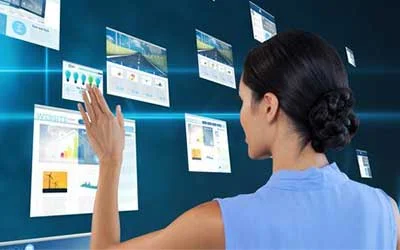Augmented reality (AR) is an exponential technology bringing radical transformations across industries through the seamless merging of physical and virtual realms. AR overlays computer-generated enhancements onto real-world views to create magical mixed-reality experiences that are visually striking, interactive, and immersive. But what really enables this smooth blending of tangible environments and intangible digital dimensions? And what does actually mesh do in augmented reality?
The answer lies in the integral framework of mesh in augmented reality serving as the scaffolding for realistic augmented reality illusions. In this extensive blog post, we will dive deep into the concept of what does the mesh do in augmented reality. Let’s get started with mesh in augmented reality meaning!
Understanding Augmented Reality Environments
Before getting into what does the mesh do in augmented reality, it is vital to establish a clear understanding of what augmented reality entails and how it aims to enhance our physical environments.
At its core, AR refers to advanced technology that superimposes virtual augmentations onto real-world views seen through devices. These enhancements come in the form of images, videos, 3D models, audio, and other computer-generated overlays that supplement physical surroundings with valuable digital dimensions. AR leverages the visualization capabilities of headsets, smartphones, tablets, and other devices to deliver this magical mixed-reality experience.
The goal is to perfectly amalgamate virtual elements with existing spaces rather than completely replace reality with simulated environments like immersive virtual reality. This seamless integration of mesh in augmented reality hinges on key AR capabilities:
- Interactive – Virtual objects respond to user actions and environmental changes through intuitive gestures and motions.
- Contextual – Digital augmentations appear firmly affixed to appropriate real-world coordinates matching their surroundings.
- Immersive – Enhancements blend realistically as if native to physical environments, creating suspension of disbelief.
Underpinning these experiences and the overall stability of AR illusions is the 3D mesh – a digital framework mapping the real world.
Functionality of Meshes in Augmented Reality
First, let’s understand the mesh in augmented reality meaning before getting into its functionality. In AR applications, a mesh refers to a detailed 3D model of the physical environment constructed from rich spatial data captured through the device’s cameras and sensors. This data includes images, videos, depth measurements, and readings from motion sensors.
Sophisticated hardware and software convert raw sensor streams into structured mesh models comprising thousands to millions of interconnected vertices, edges, and faces. Mesh in augmented reality provides an informative digital replica of the dimensions, contours, layouts, and surfaces present in the real-world setting.
So what does the mesh do in augmented reality to enable realistic AR experiences? The applications are multifold:
- Spatial Mapping: Meshes create comprehensive maps of physical surroundings critical for understanding where to convincingly anchor virtual objects. Accurately modeling static tabletop items and dynamic elements like users and pets facilitates realism.
- Occlusion: Detailed meshes allow virtual objects to realistically occlude and interact with real-world structures like hiding behind furnishings. This visual realism strengthens the AR illusion.
- User Interactivity: By continuously mapping environments and updating positions of dynamic elements like the user's hands, meshes enable natural gestural interactivity with virtual objects.
- Consistency: As users move through spaces, meshes keep virtual objects firmly fixed to appropriate environmental coordinates resulting in consistent augmentations.
Creating digital replicas of physical environments through meshes is essential to ensure that virtual enhancements are accurately placed in context. This results in truly immersive augmented reality experiences.
Constructing Augmented Reality Meshes
Generating high-fidelity meshes to enable persuasive AR illusions requires sophisticated infrastructure spanning hardware sensors and processing software. Here are some key technologies powering the creation of AR meshes:
- Depth Sensors: Specialized depth cameras like time-of-flight (ToF) and structured light sensors measure scene depth by emitting light beams and calculating their reflection times off scene surfaces. This captures intricate geometric data to construct mesh layouts and contours.
- Tracking Algorithms: Simultaneous localization and mapping (SLAM) algorithms analyze sensor data to build persistent maps of physical environments while accurately tracking the device’s evolving location within these maps. This location awareness ensures precise augmentation positioning.
- Color Sensing: RGB cameras capture color images and high-definition video of surroundings. This data gets integrated with depth measurements to colorize mesh geometry, enriching environments with realistic textures and lighting.
- Artificial Intelligence: Advanced AI techniques like semantic segmentation and machine learning models empower AR devices to make sense of environments. This facilitates intelligent interaction with distinguished objects like desks, chairs, monitors, etc.
With depth and color sensing hardware coupled with intelligent software, current AR systems can map indoor scenes with sufficient accuracy to enable applications spanning gaming, retail, and industrial design.
Limitations of Current Augmented Reality Meshes
While critical for augmentation stability, present-day AR meshes face limitations curbing widespread adoption at scale:
- Limited Mapping Range: Most smartphone AR applications are currently limited to mapping tabletop regions ranging from 0.1 to 4 meters owing to hardware sensor constraints. Mapping wider environments remains difficult.
- Inadequate Detail: Low-resolution meshes lacking rich geometrical and textual detail diminish the realism of rendered virtual objects and environment occlusions.
- Dynamic Changes: Static meshes swiftly become outdated as real-world settings undergo rearrangements and renovations, severely affecting illusion consistency.
- Extensive Compute: Highly detailed, wide-area mesh development demands intense computational horsepower exceeding smartphone and tablet capabilities. This strains resources, draining device batteries and heating processors.
With the improvement of hardware, connectivity expands through 5G, and edge computing matures to bring remote specialized resources closer to consumer devices, the scope of augmented reality mesh will scale tremendously.
The Road Ahead – Advances Enhancing Meshes
Upcoming advances across complementary technologies like depth sensing, extended reality displays, cloud computing, 5G connectivity, and edge data centers will help address many limitations:
- Novel depth modalities: Emerging depth mapping technologies like stereo cameras, optical coherence tomography, and ultrasonic sensors will capture richer 3D data from wider areas to enable expansive, detailed meshes.
- Display improvements: Higher resolution AR displays with larger fields of view will heighten the perception of intricate meshes and photorealistic occlusions, driving unprecedented immersion.
- Fog/edge computing: By 2025, deployments of localized micro data centers will reduce round-trip latencies from 100+ milliseconds to under 10 milliseconds, vastly improving remote mesh processing turnaround times.
- Expanded connectivity: The rollout of 5G and WiFi 6E will enable the rapid transmission of heavy mesh sensor data to the cloud and edge for responsive processing, overcoming mobile device limitations.
- AI enhancements: More advanced AI models leveraging neural radiance fields will create meshes directly from 2D images and video absent expensive depth sensors. Such innovations will cut costs and simplify AR adoption.
- User interaction: Leveraging technologies like radar sensing, infrared depth cameras, and lidars for capturing hand articulations will refine gesture interactions with virtual objects in AR environments.
Augmented reality mesh is set to become more expansive, seamless, and interactive by combining innovations in connectivity, computing, and sensing. It can be embedded in everyday living and leveraged for social media marketing.
Pioneering Companies Expanding Augmented Reality Mesh Capabilities
What does mesh do in augmented reality applications is essential and has become a crucial area of focus for many tech giants and popular social media platforms. Big companies like Microsoft, Facebook, Snap, and Magic Leap are investing in advancing the capabilities of mesh in AR applications.
Some sample initiatives include:
- Microsoft Mesh: Mesh platform features like shared holographic spaces, holoportation, and mixed reality capture aim to break down physical barriers enabling collaborative enterprise AR experiences mediated through photorealistic 3D avatar interactions.
- Facebook ARQ: Facebook’s AR Quality (ARQ) labs focus on mesh transmission protocols optimizing communication of meshes constructed on servers to resource-constrained client devices while preserving quality.
- Snap Scans: Snapchat’s ambitious efforts like local lenses aim to persistently map cities at street level detail to keep vast numbers of users anchored to specific locations in social AR multi-user experiences.
- Magic Leap Mesh: Magic Leap’s meshing technology generates feature-rich, physically-based rendering, achieving real-time illumination effects to enhance the realism of occlusions and lighting consistency as users move.
The increasing importance of evolving meshes can be seen in their role in facilitating augmented reality for both consumers and businesses. Several research programs are underway to explore their potential.
Conclusion
What the mesh do in augmented reality remains one of the most crucial yet invisible pillars, fundamentally empowering the magical mixed reality experiences showcased by cutting-edge augmented reality applications.
AR devices use advanced sensors and algorithms to create digital replicas of physical environments known as meshes. Meshes allow stable augmentations, realistic environment occlusion, and natural user interactivity. Despite constraints, ongoing advances will strengthen what mesh do in augmented reality, elevating our realities.
As technology continues to evolve, we can expect more innovations in AR. Invoidea, a web development company in Delhi is at the forefront of AR development and is here to help you with this evolving technology.










